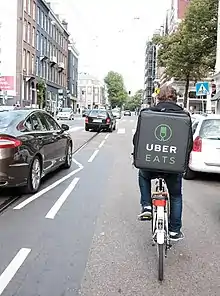Food delivery
Retail food delivery is a courier service in which a restaurant, store, or independent food-delivery company delivers food to a customer. An order is typically made either through a restaurant or grocer's website or mobile app, or through a food ordering company. The delivered items can include entrees, sides, drinks, desserts, or grocery items and are typically delivered in boxes or bags. The delivery person will normally drive a car, but in bigger cities where homes and restaurants are closer together, they may use bikes or motorized scooters. Recently, we have also seen the use of autonomous vehicles by companies like Starship Technologies, currently available in the USA and the UK to complete deliveries.
Customers can, depending on the delivery company, choose to pay online or in person, with cash or card. A flat rate delivery fee is often charged with what the customer has bought. Sometimes no delivery fees are charged depending upon the situation.[1] Tips are often customary for food delivery service. Contactless delivery may also be an option.[2]
Other aspects of food delivery include catering and wholesale food service deliveries to restaurants, cafeterias, health care facilities, and caterers by foodservice distributors.
History
The first food delivery service was for naengmyeon (cold noodle) in Korea, recorded in 1768. Haejang-guk (hangover soup) was also delivered for the yangban in the 1800s. Advertisement for food delivery and catering also appeared in the newspaper in 1906.[3][4]
Meal delivery

Meal delivery orders are typically on demand, intended to be eaten right away, and include hot, already-prepared food. While some service providers offer subscription services, ordering for delivery usually involves contacting a local restaurant or chain by telephone or online. Online ordering is available in many countries, where some stores offer online menus and ordering. Since 1995, companies such as Waiter.com have their own interfaces where customers order food from nearby restaurants that have partnered with the service. Meal delivery requires special technology and care, since the food items are already cooked and prepared, and can be easily damaged if dropped, tilted, or left out for long periods of time. Hotbags are often used to keep food warm. They are thermal bags, typically made of vinyl, nylon, or Cordura, that passively retain heat.[5]
In Mumbai, dabbawalas deliver hundreds of thousands of lunches to paying subscribers every workday through a system of rail and bicycle links. The lunches are sent in tiffin carriers, and are prepared in the late morning by either a restaurant or family member (typically a wife for a working husband, since many families still follow traditional asymmetrical gender roles). The tiffins are then returned either in the afternoon or the next day by the same system.
In the Philippines, most commonly delivered meals are from fast food chains like Jollibee, McDonald's, Pizza Hut, Shakey's, KFC, etc. Orders are being done through their delivery websites, mobile apps, or by phone. Time of delivery usually takes around 30 to 45 minutes.
In China, consumers mainly place food delivery orders via smartphone apps, with the number of users approaching 500 million people as of 2020.[6] The transaction scale of China's food delivery market is expected to eventually surpass US $129.17 billion, an increase of 14.8% year-on-year.[7]
Delivery of ingredients
Community-supported agriculture schemes work on a subscription box model, where a box of vegetables, dairy product, fish, or meat is delivered periodically from a local vendor.
Various meal kit delivery subscription services have started in Europe and North America since 2007. These typically have pre-measured ingredients designed for accompanying recipes.
Grocery delivery

Grocery delivery companies will deliver groceries, pre-prep or pre-made meals, and more to customers. The companies work with brick and mortar stores[8] or their own line of grocery items. These orders are typically larger and more expensive than normal meal deliveries, and are often not meant to be eaten right away, rather they are to replace items someone has run out of, like flour or milk. They are almost always done online, and typically take at least one day to deliver, though some companies offer same-day delivery. Many delivery services are required to offer delivery within a couple hours because frozen and fresh foods have to be delivered before they spoil.
Grocery delivery differs greatly from meal delivery in the sense that its is usually sent as a parcel through common mailing services like USPS or FedEx, if it's only non-perishables. Since non-perishable items are normally packaged before arriving at grocery stores, they can easily be repackaged and delivered to customers without any special care. Sometimes, dry ice is added to keep perishable items fresh. Fresh and frozen foods complicate delivery which is done, usually by store/provider employees or third party services such as Instacart.
The grocery delivery business has taken off, with hundreds of niche delivery companies springing up offering a variety of different services from weekly grocery restock to pre-planned, pre-measured family meals to make cooking easier. Online retailer giants have hopped on board too. Amazon.com, for example, offers AmazonFresh delivery service. Amazon purchased Whole Foods Market in 2017,[9] and by 2018 Amazon had added Whole Foods items to its Prime Now service, for 2-hour delivery in certain markets.[10]
According to Forbes,[11] grocery stores should deliver their own groceries to help prevent third party, part-time, non-store deliverers from becoming the 'face' or brand image of their local grocer. Limitations of having to pick and deliver groceries within a short period of time need to be remedied to allow for more flexibility to enable more deliveries to be more efficiently routed. Frozen and fresh food refrigeration units inside the store and the delivery vehicle, as well as lockable, consumer refrigeration boxes at the consumers home will be a solution that allows the groceries to be delivered at any time, further relieving delivery issues. This scenario will allow more local grocers to deliver with employees vs outside delivery services.
Associated fees

In addition to paying for the food, customers will often have to pay a delivery fee. The delivery fee will cover the cost of gas or other transportation costs, but usually does not go to the delivery person.[12] For meal delivery, it is common to give the deliverer an optional tip upon paying for the order. In Canada and the United States, tipping for delivery is customary. Opinions on appropriate amounts vary widely.[13] In addition, grocery stores may charge more for the foods that are ordered online for delivery than they charge for the same items off-the-shelf.
In restaurant delivery, if the delivery service is provided by a third party, such as Uber Eats or Deliveroo, the delivery fee, which can be as much as 25 or 30 percent of the value of the order, is paid by the restaurant to the service provider. In addition to the delivery fees, the service companies charge the restaurants a fee to set up the account, further cutting into the restaurants' margins.[14] Due to intense competition between the service providers wishing to sign up restaurants to use their services, restaurants have been able to negotiate lower delivery fees. McDonald's negotiated the delivery fees charged by Uber Eats from nearly 20 percent to "around 15 percent," according to a report in the Wall Street Journal.[14]
In October 2020, Montgomery County, Maryland County Executive Marc Elrich announced that he and the Montgomery County Council (Maryland) are investigating the county’s ability to force lower fees charged to restaurants by food delivery apps.[15]
Online restaurant delivery
In a 2019 market study of restaurant delivery services, the global market for online-ordered prepared food delivery was estimated at $94 billion and is estimated to grow at just over 9 percent a year, reaching $134.5 billion in 2023.[16] The study defined the market as 1)"meals ordered online which are directly delivered by the restaurant, no matter if ordered via a platform (e.g. Delivery Hero) or a restaurant website (e.g. Domino's)"; 2) online meal orders and deliveries "both carried out by a platform" (Deliveroo, UberEats, e.g.); 3) "online orders that are picked up in the restaurant" by the customer. It does not include phone orders.[16]
According to research conducted by the NDP Group, online restaurant ordering is growing 300% faster than dine-in traffic.[17]
"Online ordering has started to become the norm, thanks to the convenience, accuracy, and ability to integrate payments. At scale, ubiquitous on-demand and subscription delivery of prepared food could potentially spell the end of cooking at home.”[18]
Restaurant delivery services
In the United States, the first restaurant food delivery service in the world began in 1995 with World Wide Waiter[19][20] and still operates today as Waiter.com. The top three restaurant food delivery services are DoorDash,[21] GrubHub, and UberEats,[22] which together account for some 80 percent of the sector's revenue. The remainder is accounted for by smaller services.[23]
In Europe, major restaurant delivery services include Deliveroo, Delivery Hero/Food Panda, Just Eat Takeaway (founded in Holland in 2000 as Thuisbezorgd.nl., operates in 11 countries, including Poland, Romania, Bulgaria and Israel), UberEats and Wolt.
In South America, food delivery services include UberEats, Doordash, Grubhub, DiDi, the dominant ride-hailing company in China, and Rappi, based in Colombia. Both Didi and Rappi are funded by SoftBank, the Japanese investment fund that is also a major investor in Uber.[24]
In China, food delivery services include Alibaba-acquired Ele.me and Tencent-backed Meituan. China's food delivery market is expected to cross $21 billion in 2021.[25]
In India, the food delivery services include Zomato and Swiggy. Indian online food delivery is expected to become an $8 billion industry by 2020.[26]
In Africa, the food delivery services include UberEats currently operating in South Africa and Nairobi, Glovo currently available in Kenya,[27] Jumia Foods currently operating in Kenya, Nigeria, Algeria, Ghana, Morocco, Tunisia, Ivory Coast, and Uganda, Mr D Food currently available in South Africa, OrderIn available in South Africa, Ayazona currently available in Nairobi, and Yum Deliveries available in Kenya. Online food delivery in Africa is an emerging market that has seen a soaring growth in 2020 with new competitive market entries.[28] Online food delivery in Africa is slowly starting to take off, with multiple niche local delivery companies springing up offering a variety of different services ranging from food deliveries to groceries and house amenities delivery.
Restaurant delivery software services
As the number of restaurant food delivery systems has increased, so have the logistical challenges of tracking online orders—restaurants using delivery services usually must have each service's tablet or iPad to receive orders, which then must be transferred into the restaurant's own point-of-sales system.[29] To streamline this, software-as-a-service (SaaS) companies have emerged to integrate the online ordering, billing and dispatching of restaurant food orders.[30][31] In addition to providing online ordering software for restaurant chains (e.g. Applebee’s, Cheesecake Factory, Chipotle, Shake Shack), these SaaS companies' digital platforms also provide data analysis that these restaurants use for medium- and long-term planning.[30][31]
Ghost kitchens
As the food delivery sector has grown, restaurants have turned to "ghost kitchens", also known as "cloud kitchens", to fill the need for inexpensive kitchen space to handle the increased volume.[32] A ghost kitchen site will be purpose-built to be delivery-only and have separate areas of stoves, refrigeration and storage space to accommodate food preparation teams of several different restaurants.[33] As they are often located in less densely populated areas of a city, they also have parking areas for the delivery vehicles. Companies providing this service are often subsidiaries of the delivery companies. Ghost kitchens also allow for the creation of virtual restaurant brands—restaurants that exist only online, with no bricks-and-mortar presence.[32]
See also
References
- "Uber Eats waives delivery fee for independent restaurants as virus spreads". Reuters. 2020-03-16. Retrieved 2020-03-23.
- Is It Safe To Order Takeout During The Coronavirus Outbreak?
- "배달음식 1호, 1768년 7월 냉면". Seouland.com (in Korean). Retrieved 13 November 2017.
- "여름철 대표 먹거리 '냉면' 언제부터 인기 있었을까?". Kids.hankooki.com (in Korean). Retrieved 13 November 2017.
- "Pizza Hut Just Fixed The Biggest Problem About Getting Pizzas Delivered". Delish. 2017-10-11. Retrieved 2017-12-28.
- "In China, food delivery order volume crosses 500 million users in 2020". Startup News, Networking, and Resources Hub | BEAMSTART. Retrieved 2021-01-04.
- AI, China Money (2021-01-02). "China Tech Digest: Online Food Delivery Users Reach 500M, China Box Office Hit RMB20B In2020". China Money Network. Retrieved 2021-01-04.
- "Kroger has a game-changing new grocery service, and moms are freaking out about it". Business Insider. Retrieved 2017-12-28.
- "After Amazon-Whole Foods deal, grocery delivery companies adapt". statesman. Retrieved 2017-12-28.
- "Amazon Expands Two-Hour Whole Foods Delivery to Catch Walmart". www.bloomberg.com. 2019-09-20. Retrieved 2020-03-12.
- Ladd, Brittain (December 24, 2018). "Shakeup On Aisle Five: Will Grocery Retailers Abandon Instacart?". Forbes.com. Forbes Publlishing. Retrieved 18 June 2019.
- "A Common Misconception Is Cutting Into Pizza Delivery Drivers' Pay". Business Insider. Retrieved 2017-12-28.
- "How much to tip? Well, it depends. 4 tips to make it less taxing". USA TODAY. Retrieved 2017-12-28.
- Haddon, Heather (June 23, 2019). "Restaurants are Arm-Twisting Delivery Companies to Lower Fees". WSJ.com. Wall Street Journal, Dow Jones, Inc. Retrieved 25 June 2019.
As they fight for market share, some delivery companies have become more willing to cede better terms to restaurants.
- "County Executive, Council Investigating Food Delivery App Fees". Source of the Spring. Retrieved 24 October 2020.
- "Online Food Delivery worldwide". Statista.com. Statista. Retrieved 18 June 2019.
- "Restaurant takeout and delivery are taking a bite out of dine-in traffic". Nation's Restaurant News. 2016-06-24. Retrieved 2018-10-11.
- "Millennials are spending a lot less time cooking, and it could hurt America's biggest food companies". www.msn.com. Archived from the original on 11 October 2018. Retrieved 2018-10-11.
- Riley, Sheila (November 12, 1998). "Eateries Step To Plate. Offer Meals ViaWeb". Investor's Business Daily.
- "How to Make Lunch an Adventure". partners.nytimes.com. Retrieved 2017-09-19.
- "DoorDash continues to lead in the food delivery wars". CNBC.
- "Survey: People Willing to Pay More For Food Delivery". U.S. News.
- "DoorDash Surpasses GrubHub in National Market Share of Total Consumer Spend with 28% to 27%, with Uber Eats taking 25%". Edison.Tech. Edison Software. March 1, 2019. Retrieved 18 June 2019.
- Whelan, Robbie; Brown, Eliot (January 30, 2020). "SoftBank Is Funding Every Side of a Bruising Startup Battle; Money from the Japanese tech investor is fueling a price war in Latin America between three of its own: Uber, Didi and Rappi". The Dow Jones Company. ProQuest 2348240181. Cite journal requires
|journal=(help) - "Food Delivery App Market [Sector Profile]". Business of Apps. 2020-10-29. Retrieved 2021-01-04.
- "Indian online food delivery market to hit $8bn by 2020". businessinsider.in. business insider india. Retrieved 13 July 2020.
- "On-demand delivery app Glovo has launched its operations in Nairobi". capitalfm.co.ke. capital fm kenya. Retrieved 2 February 2019.
- "Food delivery in Africa is soaring because of Covid-19 and more companies are expanding to cater to the business". africa.businessinsider.com. business insider africa. Retrieved 24 August 2020.
- Wen, Melissa (August 26, 2017). "Food delivery creates tech headache for some U.S. restaurants". Reuters.com. Thompson-Reuters. Retrieved 25 June 2019.
Four tablets from various delivery companies crowd the front counter of Proposition Chicken in San Francisco
- Dunn, Elizabeth (4 February 2019). "Farm to Desk" (4602). Bloomberg LLC. Bloomberg BusinessWeek.
Many restaurants lack the expertise or investment necessary to build their own digital ordering systems. They turn to software providers
- Loizos, Connie (January 9, 2019). "Tiger Global just invested $18 million in Olo, a low-flying ordering platform for more than 50,000 fast-casual restaurants". TechCrunch. Tech Crunch Verizon Media. Retrieved 18 June 2019.
- Isaac, Mike; Yaffe-Bellany, David (August 19, 2019). "In These Restaurants Every Order is to Go". The New York Times. p. B1. Retrieved 4 September 2019.
- Albrecht, Chris (May 21, 2018). "Kitchen United Launches to Help Restaurants Meet Delivery Demand". Spoon.com. The Spoon.
